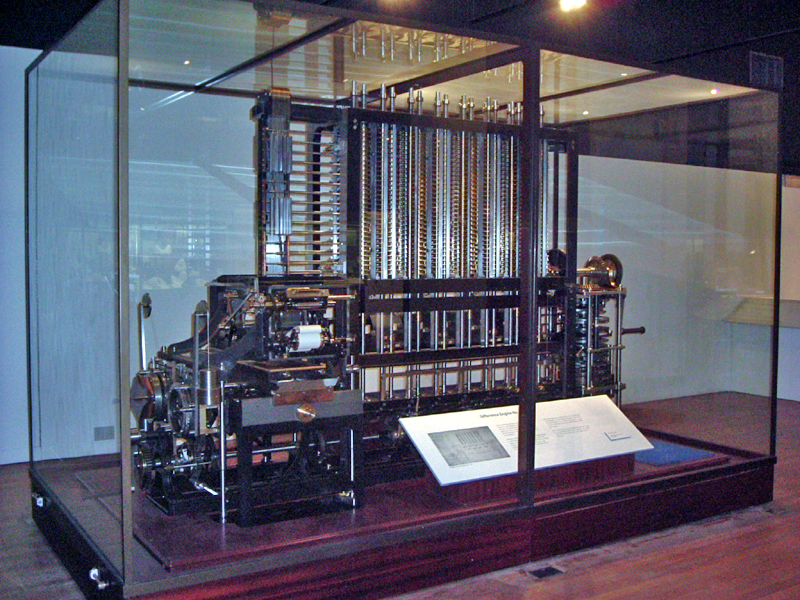 Charles Babbage, FRS (26 December 1791 – 18 October 1871)was an English mathematician, philosopher, inventor and mechanical engineer who originated the concept of a programmable computer. Parts of his uncompleted mechanisms are on display in the London Science Museum. In 1991, a perfectly functioning difference engine was constructed from Babbage's original plans. Built to tolerances achievable in the 19th century, the success of the finished engine indicated that Babbage's machine would have worked. Nine years later, the Science Museum completed the printer Babbage had designed for the difference engine, an astonishingly complex device for the 19th century. Considered a "father of the computer"Babbage is credited with inventing the first mechanical computer that eventually led to more complex designs.
Charles Babbage, FRS (26 December 1791 – 18 October 1871)was an English mathematician, philosopher, inventor and mechanical engineer who originated the concept of a programmable computer. Parts of his uncompleted mechanisms are on display in the London Science Museum. In 1991, a perfectly functioning difference engine was constructed from Babbage's original plans. Built to tolerances achievable in the 19th century, the success of the finished engine indicated that Babbage's machine would have worked. Nine years later, the Science Museum completed the printer Babbage had designed for the difference engine, an astonishingly complex device for the 19th century. Considered a "father of the computer"Babbage is credited with inventing the first mechanical computer that eventually led to more complex designs.His father's money allowed Charles to receive instruction from several schools and tutors during the course of his elementary education. Around the age of eight he was sent to a country school in Alphington near Exeter to recover from a life-threatening fever. His parents ordered that his "brain was not to be taxed too much" and Babbage felt that "this great idleness may have led to some of my childish reasonings." For a short time he attended King Edward VI Grammar School in Totnes, South Devon, but his health forced him back to private tutors for a time.He then joined a 30-student Holmwood academy, in Baker Street, Enfield, Middlesex under Reverend Stephen Freeman. The academy had a well-stocked library that prompted Babbage's love of mathematics. He studied with two more private tutors after leaving the academy. Of the first, a clergyman near Cambridge, Babbage said, "I fear I did not derive from it all the advantages that I might have done." The second was an Oxford tutor from whom Babbage learned enough of the Classics to be accepted to Cambridge.
Babbage arrived at Trinity College, Cambridge in October 1810. He had read extensively in Leibniz, Joseph Louis Lagrange, Thomas Simpson, and Lacroix and was seriously disappointed in the mathematical instruction available at Cambridge. In response, he, John Herschel, George Peacock, and several other friends formed the Analytical Society in 1812. Babbage, Herschel and Peacock were also close friends with future judge and patron of science Edward Ryan. Babbage and Ryan married two sisters.
In 1812 Babbage transferred to Peterhouse, CambridgeHe was the top mathematician at Peterhouse, but did not graduate with honours. He instead received an honorary degree without examination in 1814.
Babbage sought a method by which mathematical tables could be calculated mechanically, removing the high rate of human error. Three different factors seem to have influenced him: a dislike of untidiness; his experience working on logarithmic tables; and existing work on calculating machines carried out by Wilhelm Schickard, Blaise Pascal, and Gottfried Leibniz. He first discussed the principles of a calculating engine in a letter to Sir Humphry Davy in 1822.
 Babbage's machines were among the first mechanical computers, although they were not actually completed, largely because of funding problems and personality issues. He directed the building of some steam-powered machines that achieved some success, suggesting that calculations could be mechanized. Although Babbage's machines were mechanical and unwieldy, their basic architecture was very similar to a modern computer. The data and program memory were separated, operation was instruction based, the control unit could make conditional jumps and the machine had a separate I/O unit.
Babbage's machines were among the first mechanical computers, although they were not actually completed, largely because of funding problems and personality issues. He directed the building of some steam-powered machines that achieved some success, suggesting that calculations could be mechanized. Although Babbage's machines were mechanical and unwieldy, their basic architecture was very similar to a modern computer. The data and program memory were separated, operation was instruction based, the control unit could make conditional jumps and the machine had a separate I/O unit.
The London Science Museum has constructed two Differe nce Engines, according to Babbage's plans for the Difference Engine No 2. One is owned by the museum; the other, owned by technology millionaire Nathan Myhrvold, went on exhibit at the Computer History Museum in Mountain View, California on 10 May 2008. The two models that have been constructed are not replicas; until the assembly of the first Difference Engine No 2 by the London Science Museum, no model of the Difference Engine No 2 existed.
nce Engines, according to Babbage's plans for the Difference Engine No 2. One is owned by the museum; the other, owned by technology millionaire Nathan Myhrvold, went on exhibit at the Computer History Museum in Mountain View, California on 10 May 2008. The two models that have been constructed are not replicas; until the assembly of the first Difference Engine No 2 by the London Science Museum, no model of the Difference Engine No 2 existed.
0 comments: